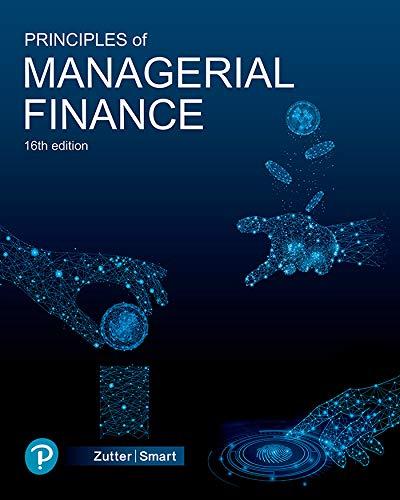Question
As a financial consultant, you have contracted with Wheel Industries to evaluate their procedures involving the evaluation of long term investment opportunities. You have agreed
As a financial consultant, you have contracted with Wheel Industries to evaluate their procedures involving the evaluation of long term investment opportunities. You have agreed to provide a detailed report illustrating the use of several techniques for evaluating capital projects including the weighted average cost of capital to the firm, the anticipated cash flows for the projects, and the methods used for project selection. In addition, you have been asked to evaluate two projects, incorporating risk into the calculations.
You have also agreed to provide an 8-10 page report, in good form, with detailed explanation of your methodology, findings, and recommendations.
Company Information
Wheel Industries is considering a three-year expansion project, Project A. The project requires an initial investment of $1.5 million. The project will use the straight-line depreciation method. The project has no salvage value. It is estimated that the project will generate additional revenues of $1.2 million per year before tax and has additional annual costs of $600,000. The Marginal Tax rate is 35%.
Required:
- Wheel has just paid a dividend of $2.50 per share. The dividends are expected to grow at a constant rate of six percent per year forever. If the stock is currently selling for $50 per share with a 10% flotation cost, what is the cost of new equity for the firm? What are the advantages and disadvantages of using this type of financing for the firm?
- The firm is considering using debt in its capital structure. If the market rate of 5% is appropriate for debt of this kind, what is the after tax cost of debt for the company? What are the advantages and disadvantages of using this type of financing for the firm?
- The firm has decided on a capital structure consisting of 30% debt and 70% new common stock. Calculate the WACC and explain how it is used in the capital budgeting process.
- Calculate the after tax cash flows for the project for each year. Explain the methods used in your calculations.
- If the discount rate were 6 percent calculate the NPV of the project. Is this an economically acceptable project to undertake? Why or why not?
- Now calculate the IRR for the project. Is this an acceptable project? Why or why not? Is there a conflict between your answer to part C? Explain why or why not?
Wheel has two other possible investment opportunities, which are mutually exclusive, and independent of Investment A above. Both investments will cost $120,000 and have a life of 6 years. The after tax cash flows are expected to be the same over the six year life for both projects, and the probabilities for each year's after tax cash flow is given in the table below.
| Investment B | Investment C | |||
| Probability | After Tax Cash Flow |
| Probability | After Tax Cash Flow |
| 0.25 | $20,000 |
| 0.30 | $22,000 |
| 0.50 | 32,000 |
| 0.50 | 40,000 |
| 0.25 | 40,000 |
| 0.20 | 50,000 |
- What is the expected value of each project
Step by Step Solution
There are 3 Steps involved in it
Step: 1

Get Instant Access to Expert-Tailored Solutions
See step-by-step solutions with expert insights and AI powered tools for academic success
Step: 2

Step: 3

Ace Your Homework with AI
Get the answers you need in no time with our AI-driven, step-by-step assistance
Get Started


